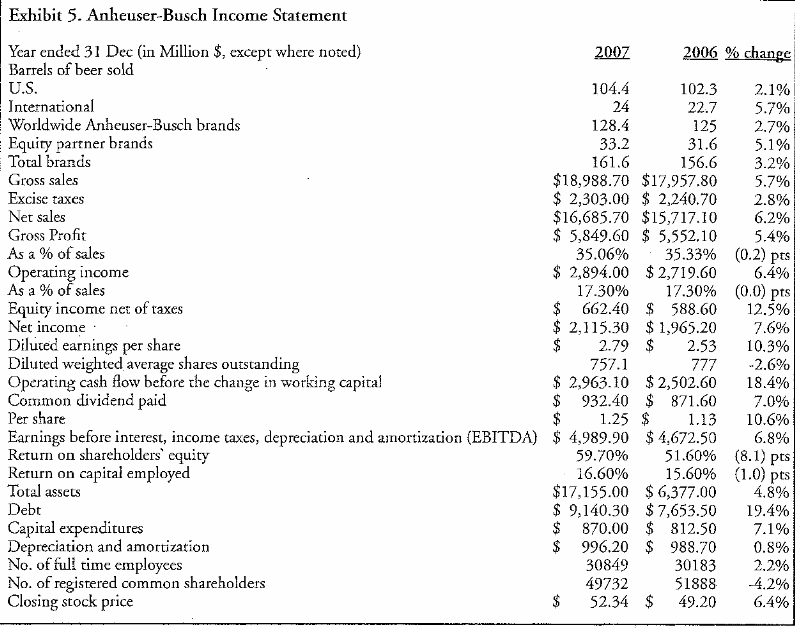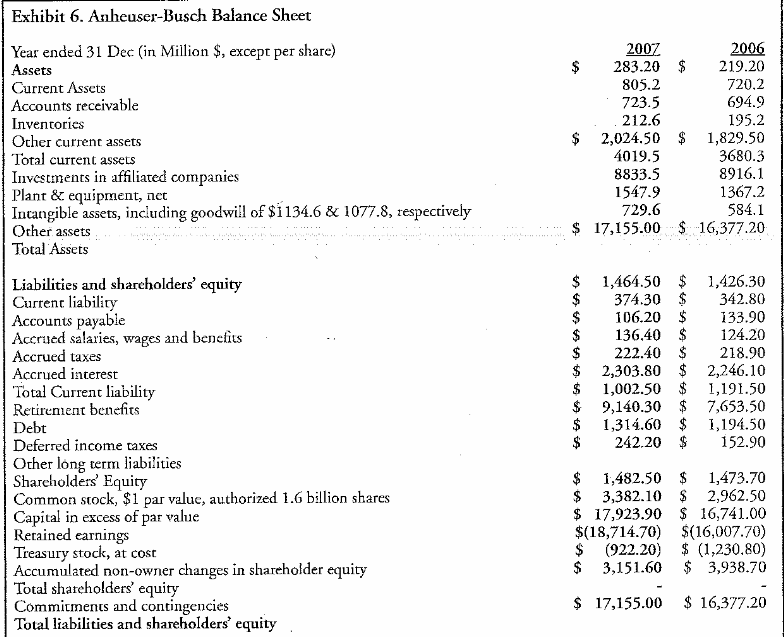Description of InBev Company
This is a company that resulted from the merger between AmBev and Interbrew in 2004. Interbrew was ranked third largest in the entire world in terms of profit margins with most of its sales emerging from North America, as well as, Europe, leading to a total of 120 countries being captured in the marketing strategy.
On the other hand, AmBev was ranked fifth in the global market with most of its sales centered in Latin America. The merger between the two companies was strategic in terms of business development of both companies resulting into a new brand name- InBev.
It should be noted that the mutual intention for both companies was related to gaining of market share value in the respective regions where the counterpart company was strongest, i.e. AmBev’s intention was to gain a foothold in the Northern America and Europe where its brands had not been fully introduced while Interbrew had intentions of fully launching its brands in Latin America.
As a result, it can be noted that the intentions by both companies were strategically business-sensible since they would lead to more sales for both partners due to expansion to foreign untapped markets.
InBev launched its bid to acquire Anheuser-Busch Company in 2008 in a deal that would see the company paying extra, in order to close the deal. InBev placed a bid of $46.4 Billion in order to acquire Anheuser-Busch in a deal that would see the merger of the two companies form the strongest and largest brewer in the world with an estimate of about $36 billion worth of sales annually.
With the Anheuser-Busch rejecting the initial offer of $65 per share by InBev, the CEO of InBev raised the bid to $70 per share, willing to go extra heights in order to close the deal. This represents a major step whose long term corporate strategy would have to produce maximum estimated returns.
Problem Statement
What is the rationale for the deal in which InBev Company is willing to pay up to $70 per share in order to acquire Anheuser-Busch Company?
Analysis of the estimated Value this deal will create for InBev
In order to comprehensively answer the question presented above in the problem statement, it is important to critically evaluate the potential benefits that InBev Company estimates to achieve in acquiring Anheuser-Busch Company that would justify the decision to pay the high premiums. An analysis of this issue will require an in-depth examination of the potential benefits lying ahead after the closure of this deal.
First, InBev is estimating to increase its sales to approximately $36 billion dollars annually. The Budweiser brand from the Anheuser-Busch Company maintains a dominant lead in terms of sales in America, having done well in the market for the last 139 years.
An acquisition of this company by InBev brings forth huge financial benefit since the dominant value of Budweiser in American market will help InBev to achieve its goals in expanding dominance in the American Continent market environment.
According to the CEO of InBev, this deal would create a competitive advantage for the company since the sales are estimated to go higher with annual estimates rising to $36 billion. This would represent excessive sales in the American markets through the sale of Budweiser brand, as well as, benefits of international sales emanating from the sales of brands from InBev Company. As a result, it can be noted that this deal will be a potential benefit for InBev leading to a justification of the high premiums paid for the acquisition procedure.
The creation of the world leading brewer industry is another justification for the acquisition. This acquisition deal will lead to the formation of the world’s largest brewing industry since it will constitute the combination of the world’s fourth largest producer (Anheuser-Busch) and the second largest producer (InBev).
As a result, it can be observed that the acquisition will lead to the formation of a major company that will gain variety of potential benefits in the beer industry. As a matter of fact, InBev is estimated to benefit from the market share in Europe and American continents.
Since Anheuser is majorly dominant within the American continent occupying up to 50% of the market share due to the sale of its brands, the combination of sales from Europe that will emanate from the InBev companies will create a major boost for InBev due to the increased market share.
As a result, InBev is estimated to increase in net profit margins through expansion and increased sales due to variety of beer products from the company. In addition, the highly estimated sales will be helpful in terms of giving InBev absolute opportunity to dominate the beer industry by investing the money into research in the market to find out the existing untapped markets, as well as, the changing tastes of the consumers and customers (Mitchell-Lee and Mirvis 23). As a result, this will create an effective corporate strategy by the company that will lead to more potential benefits of the company.
Third, this deal will ensure that all the US breweries remain open. Due to the threat of global recession, the chance of companies going bankrupt is a likely possibility. Efforts to consolidate unity in the market in such tough financial seasons would be necessary in terms of ensuring that the beer industry stays alive in the global business environment.
It should be noted that the government policies that may be launched by various government s in response to the global financial crisis may be unfavorable to the beer business.
As a result, the decision of InBev to pay high premium in order to acquire Anheuser-Bush, is an effective corporate strategy that will not only strengthen the stakes of the company, but also, help the breweries within the American continent to stay open and operational within the tough financial season in the global environment.
As a result, it should be noted that it was a good corporate strategy for the CEO of InBev to invest in the acquisition of Anheuser-Busch Company at the time.
Creation of large chain of employees and executive managers of both companies is another justification for the high premiums paid by InBev in the acquisition procedure. It should be understood that the acquisition would create a large pool of employees from both companies which would potentially create great manpower resource since highly-skilled employees from one company can be deployed to other non-performing branches of the company to create a turn-around which would be financially useful for the company.
In addition, the inclusion of the board of directors from Anheuser-Busch Company will provide more executive and intellectual management skills that will help InBev to scale higher heights in the global environment in terms of management.


Works Cited
Mirvis, Philip, and Mitchell-Lee, Marks. Joining Forces: Making One Plus One Equal Three in Mergers, Acquisitions, and Alliances. New York: MacMillan Library Reference, 1998. Print.